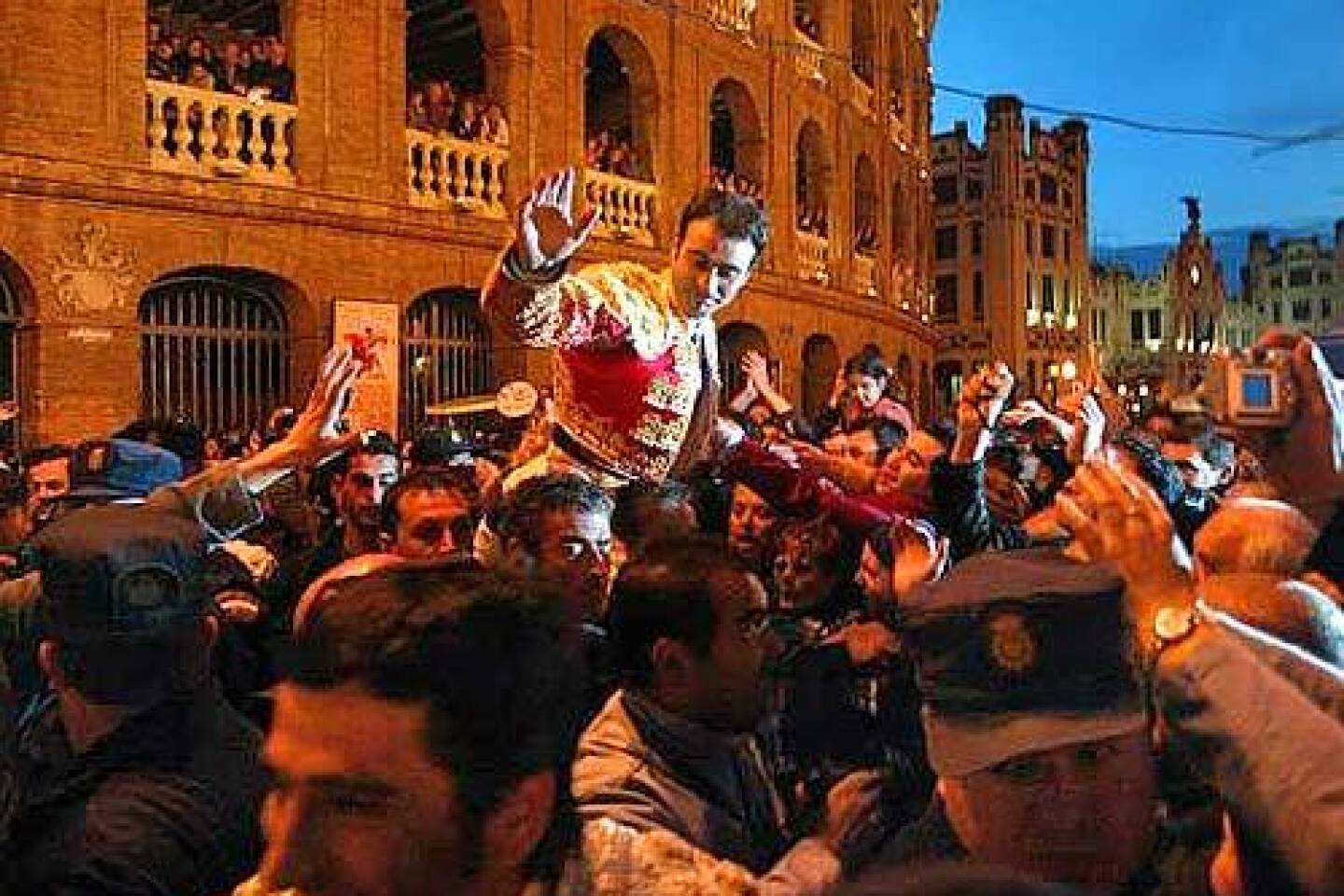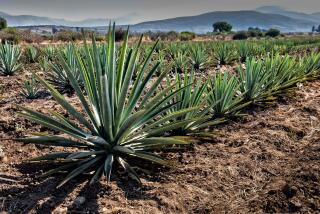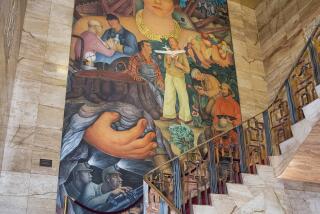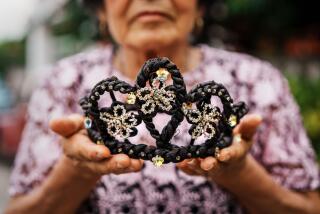The ciudad, in a new light
IT wasn’t over until the fat lady melted.
And melt she did, going up in flames as a barrage of fireworks illuminated the midnight sky and the crowd cheered. The heat stung my face, and ashes rained down as the flames consumed her.
She was part of a towering falla — the last left standing of the 385 float-like constructions of wood, papier-mâché, polystyrene and wax that only hours earlier had dominated Valencia’s squares and intersections. It fell piece by piece onto Plaza del Ayuntamiento. A band struck up “Valencia,” the unofficial anthem of this city on the eastern shore of Spain.
By 1:20 a.m., the falla, a comical tribute to great Spanish artists, was little more than a giant bonfire. The crowd roared when the biggest board of its wooden skeleton crashed to the ground in a shower of sparks. As the last ember faded, Las Fallas, Valencia’s annual goodbye to winter, was officially over.
I had come here in mid-March to take in the sights and sounds — what sounds! — of Las Fallas, a festival that is a bit religious, a bit raucous and unlike anything I had ever experienced.
Wanting to get a feel for the city as well as for the festival, I budgeted six days in Valencia, Spain’s third-largest city with a population of about 786,000. Unlike Madrid, about 200 miles west, and Barcelona, about 200 miles north, it’s not a major magnet for American tourists.
That may change. It’s expected to attract thousands of visitors, including many from the U.S., as host city for the 32nd America’s Cup yacht regatta from June 23 to July 7, 2007. Four new luxury hotels are set to open by then.
For now, I found a charming city of bell towers and blue-tiled domes, with a picturesque medieval quarter of narrow streets opening onto plazas. In marked contrast is the futuristic Ciudad de las Artes y las Ciencias, or the City of Arts and Sciences, designed largely by internationally acclaimed architect and native son Santiago Calatrava.
Stunning architecture
ON my first morning in Valencia, I walked to “the river” with my terrific English-speaking guide, Josep Alberoca. Although people “still say, ‘Let’s go down to the river,’ ” Alberoca said, the Turia doesn’t actually flow through the city. It was rerouted after overflowing its banks in 1957, causing dozens of deaths.Today, the riverbed, spanned by four bridges, is a ribbon of park with Mediterranean vegetation, fountains, ponds and pedestrian and bike paths. A pleasant walk of about 45 minutes brought us to the City of Arts and Sciences, a complex of architecturally stunning white buildings occupying an 87-acre site that had been inhabited by squatters.
Its transformation began with the opening in 1998 of Hemispheric, an eyeball-like structure housing a planetarium and an Imax theater, and was completed in October with the opening of the Palau de les Artes, a concrete oval resembling a Trojan helmet with its feather-like steel plume. With four performing-arts halls, it will be home to an annual international competition for young opera singers. The contest will be overseen by Spanish tenor Plácido Domingo, general director of Los Angeles Opera.
Music is part of Valencia’s soul. “In Valencia when you’re born, they give you instead of a pacifier a musical instrument,” Alberoca said.
The complex includes the interactive Prince Felipe Museum of the Sciences, which brings to mind the bleached skeleton of some enormous creature.
“People used to come to Valencia just for the sunny conditions and the paella,” said Patricia Picó, the museum’s media relations director, but that all changed with the coming of the Ciudad, which includes Oceanographic, called the largest aquarium in Europe.
The aquarium, created by Spanish architect Felix Candela, is a marine park with a series of pavilions named for oceans and seas, each housing species native to that area. As I walked through a glass-roofed tunnel, a shark swam overhead, baring its teeth.
Completing the complex is the Umbracle, a covered garden promenade from which visitors have a fine view of the Ciudad’s buildings, lakes and reflecting pools.
Even outside of Las Fallas and the Ciudad, Valencia has plenty to see.
One night Alberoca led me through the streets of old town to the not-to-be-missed 15th century La Lonja de la Seda (Silk Exchange) on Plaza del Mercado. Here, merchants from throughout Europe once traded — until the silk industry was devastated by a mulberry tree disease. In the stunning Hall of Pillars, stone columns fashioned like twisted silk fan out like palm trees where they meet the vaulted ceiling.
We walked the lively streets of the once crime-riddled Barrio del Carmen, now abuzz with clubs, restaurants and shops, and visited Valencia’s 13th- to 15th-century cathedral, which houses an agate chalice believed by some to be the one Christ drank from at the Last Supper. In the chapel of the Borgia family — yes, they came from Valencia — is Francisco de Goya’s hauntingly dark painting, “Saint Francis Borgia at the Deathbed of an Impenitent,” depicting ghouls hovering over a dying sinner.
One morning I went to the harbor, where preparations were underway for the America’s Cup. Officials hope improvements to the long-neglected waterfront will have long-term benefits, such as attracting more cruise ships, said Rafael Soriano, infrastructures manager for Valencia 2007. It is the fulfillment of a dream, he said, to create “the balcony to the sea that Valencia always wanted to build.” Post-America’s Cup, it will be pedestrian-friendly, with hotels, shops and restaurants.
Valencia is the birthplace of paella, the rice dish created by laborers in those orange groves as a cheap lunch, and there are many interpretations. But true Valencian paella contains chicken, rabbit and snails. (Not only does Valencia have its signature dish but also its own idiom, called Valenciano.)
In the heart of the old city, I visited the National Ceramics Museum, in an 18th century palace with a wonderfully over-the-top carved alabaster Churrigueresque portal and a collection that ranges from 10th century Muslim ceramics to 1950s Picassos. I loved the replica of a traditional Valencian kitchen, with its old cooking utensils and walls covered in predominantly blue and white glazed azulejo tile.
Blazing floats
FOR the best of all worlds, though, come to Valencia from March 15 to 19, when Las Fallas fever grips the city, and perfectly sane people set off firecrackers on the sidewalks and gleefully watch each blazingfalla.
Only hours after arriving from Los Angeles, I was at the Convento de Jerusalén to see my first falla, an Egyptian fantasy 88 feet tall, complete with a comical pharaoh with a virility problem, a few eunuchs, Cleopatra in her bath, Nubian slaves, a Nile barge, sphinxes and an asp.Like many fallas, it had been a year in the making — and cost the neighborhood association that sponsored it about $290,000. Now its creators were overseeing final touches before the judging. (It would be awarded second prize in the prestigious large fallas division.)
Las Fallas is about renewal, about hope rising from the ashes, winter giving way to spring, worries vanishing.
It’s also a lot of fun.
I walked from square to square one morning, stopping at the Horchateria el Collado in Plaza del Doctor Collado for buñuelos, the sugared pumpkin fritters that are a Fallas tradition, and a cup of thick, dark hot chocolate.
I then strolled through Mercado Central, the huge tile-domed 1928 Art Nouveau covered market, all iron and stained glass.
Then there were more fallas to see. There were beautiful fallas, funny fallas and fallas that made political statements. (President Bush appeared on one this year.)
One was a gigantic salute to Cervantes and Don Quixote — no satiric intent here. “The big fallas, they want to get prizes, so they’re sweet, polite,” said Nacho Garcia of Valencia Tourism. “But the poor [small-scale] fallas, it’s like, wow!” No one is safe from the barbs. One made a statement against steroid-abusing athletes; another took a swipe at environmentally destructive tourism; others took on graffiti and public urination.
Fallas have small figures, called ninots, and the ninot judged best each year earns a permanent spot in the Fallas Museum in Plaza Monteolivete. There, I traced the evolving sophistication of falla construction over 70 years and saw fallas that broadcast subversive messages protesting conditions under the authoritarian regime of Gen. Francisco Franco, who died in 1975.
The origin of this multifaceted festival is debatable, but Felix Crespo, president of Junta Central Fallera, the organizing committee, said he subscribed to the popular theory that Las Fallas began in the 17th century, when on the eve of the day of St. Joseph, patron saint of carpenters, the carpenters would burn their sweepings and the standing poles that held their oil lamps. In time, they began decorating the poles as grotesque figures of rivals.
Soon, it was time for me to experience my first mascletá, the daily daytime fireworks display. I joined a group, including Las Fallas queen Gueguel Massmanian, on the City Hall balcony. People had squeezed onto balconies and rooftops and filled the street below.
The queen and her court were resplendent in elaborate long brocade and lace gowns, with gold combs in their hair.
The band was playing “Valencia.” The queen said something like “Let the fireworks begin.”
The vibrations of exploding gunpowder and screaming rockets rattled my spine and caused my ears to hurt and itch simultaneously.
“It has to be loud. It’s like carnival in Brazil,” Juan Perra of Pirotecnia Turis, the company that created the big booms, explained to me later. “It’s not noise because of noise. It’s like a song that goes from low to high. Mediterranean fireworks are the liveliest. It goes along with the personality of the population.”
The fireworks, the hoopla, the bullfights were preludes to the main events — the Ofrenda de Flores (flower offering) to Our Lady of the Forsaken, the patron saint of Valencia, and then La Crema, when the fallas are set ablaze.
Over two evenings, about 150,000 men, women and children — including fallas commissions, their queens and courts — joined the Ofrenda procession, bringing pink, red and white flowers to fashion the cloak of the Virgin, which stood 46 feet tall in Plaza de la Virgen in the heart of old Valencia.
The plaza was a sea of flowers. Ornately costumed women wept and crossed themselves as they handed their bouquets to those decorating the floral cloak. Accompanying most groups was a band playing “Valencia” (“where the orange trees forever scent the breeze beside the sea “)
When I think of Valencia, I will think not of orange trees but of Las Fallas. Of fireworks like a dozen Fourth of Julys. Of walks down streets aglow with thousands of twinkling lights arcing overhead.
In the early morning hours of March 20, it was all over. It finished with a bang, not a whimper.
The fat lady had melted.
For a sampling of the song “Valencia” and a gallery of photos, go to latimes.com/valencia.
*(BEGIN TEXT OF INFOBOX)
Valencia gets lively
GETTING THERE:
From LAX, Air Tahiti Nui, Air France, British, US Airways and Lufthansa offer connecting service (change of planes) to Valencia. Restricted round-trip fares begin at $651 until Dec. 9 and Dec. 27-March 31; $974 Dec. 10-26.
TELEPHONES:
To call the numbers below from the U.S., dial 011 (the international dialing code), 34 (the country code for Spain), 96 (the area code for Valencia) and the local number.
WHERE TO STAY:
Palau de la Mar, 14-16 Navarro Reverter; toll-free number is (866) 376-7831, https://www.epoquehotels.com . Stunning 66-room contemporary boutique hotel in two 19th century palaces half a mile from the city center. Doubles from $140.
Astoria Palace, 5 Plaza Rodrigo Botet; 398-1000, https://www.hotel-astoria-palace.com . Well-situated traditional hotel with recently renovated rooms. Popular rooftop restaurant. Doubles from $113.
Vincci Lys, 5 Martínez Cubells; 350-9550, https://www.hotelvinccilys.com . Rub elbows with matadors from the nearby bullring at this mid-size hostelry in the old city. Commercial but inviting. Doubles from $106.
WHERE TO EAT:
La Sucursal, in the Modern Art Museum, 118 Guillem de Castro; 374-6665. Pretty, popular and pricey. Iberian specialties — rabbit, ox filet, lobster — with most entrees starting at $23.
Bamboo, 19 Jorge Juan; 353-0337. Pastas, rice dishes, fish and meat in an eye-catching minimalist space in renovated Mercado Colón. Entrees $10.50-$18.
Les Graelles, 2 Calle Arquitecto Mora; 360-4700. Traditional Valencian menu and Spanish décor — dark wood and wrought iron. Signature dishes include lobster paella and frozen orange souffle. Entrees $18-$24.
Seu-Xerea, 4 Conde de Almodóvar; 392-4000, https://www.seuxerea.tdv.net . Mediterranean and Asian fusion cuisine in an attractive, very “in” place in a lively old city neighborhood. Entrees $20-$23.
La Sidreria, three locations, including 55 Avenida Francia, near Ciudad de las Artes y las Ciencias; 330-2923. Serves tapas, which start at about $7.
TO LEARN MORE:
Valencia Tourism & Convention Bureau, 360-6353, https://www.turisvalencia.es .
Josep Alberoca, 385-1740, https://www.valenciaguias.com . An excellent English-speaking guide.
Tourist Office of Spain; (323) 658-7188, https://www.okspain.org .
— Beverly Beyette
More to Read
Sign up for The Wild
We’ll help you find the best places to hike, bike and run, as well as the perfect silent spots for meditation and yoga.
You may occasionally receive promotional content from the Los Angeles Times.














